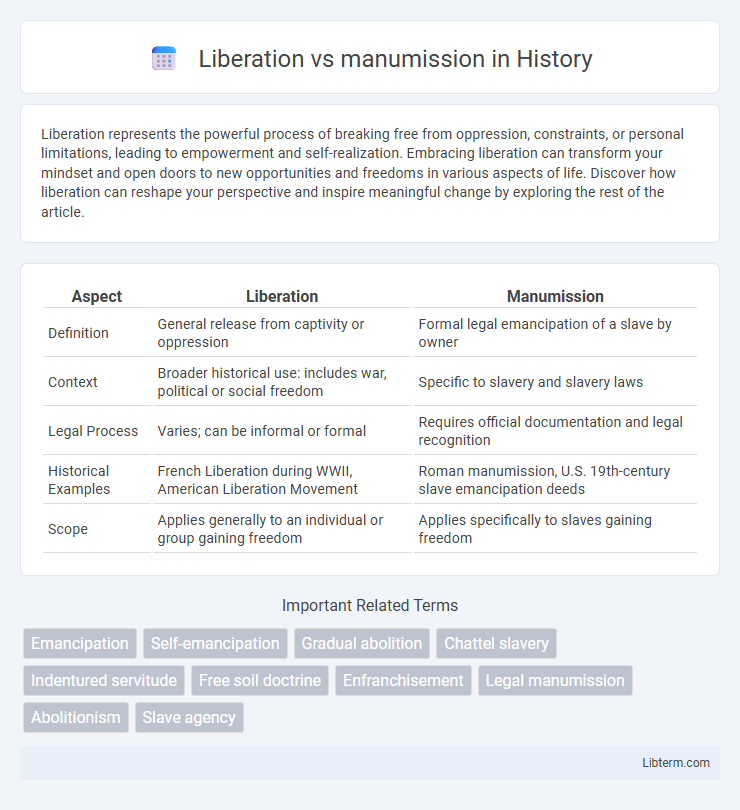Liberation represents the powerful process of breaking free from oppression, constraints, or personal limitations, leading to empowerment and self-realization. Embracing liberation can transform your mindset and open doors to new opportunities and freedoms in various aspects of life. Discover how liberation can reshape your perspective and inspire meaningful change by exploring the rest of the article.
Table of Comparison
| Aspect | Liberation | Manumission |
|---|---|---|
| Definition | General release from captivity or oppression | Formal legal emancipation of a slave by owner |
| Context | Broader historical use: includes war, political or social freedom | Specific to slavery and slavery laws |
| Legal Process | Varies; can be informal or formal | Requires official documentation and legal recognition |
| Historical Examples | French Liberation during WWII, American Liberation Movement | Roman manumission, U.S. 19th-century slave emancipation deeds |
| Scope | Applies generally to an individual or group gaining freedom | Applies specifically to slaves gaining freedom |
Understanding Liberation and Manumission: Key Differences
Liberation refers to the broader concept of freeing individuals or groups from oppression, captivity, or slavery, often encompassing social, political, and systemic contexts. Manumission specifically denotes the formal legal act of an owner freeing a slave, typically documented through a deed or legal declaration in historical and legal frameworks. Understanding the key differences involves recognizing liberation as a comprehensive and often collective process, while manumission is a precise, individual legal release from bondage.
Historical Contexts of Liberation and Manumission
Liberation historically refers to the broader process of freeing entire groups or nations from oppressive regimes, often tied to wars of independence and revolutions, such as the abolition of slavery during the American Civil War or the decolonization movements in Africa and Asia. Manumission specifically denotes the legal act of an individual enslaver freeing a single enslaved person, which was common in ancient Rome, Greece, and the antebellum American South, often documented through formal decrees or legal contracts. The contrast in historical contexts highlights liberation as a collective political transformation while manumission remains a personal, legally mediated emancipation within established systems of slavery.
Legal Frameworks: Pathways to Freedom
Liberation and manumission represent distinct legal pathways to freedom within historical and contemporary legal frameworks, with manumission typically referring to the formal, often documented emancipation granted by slave owners. Liberation, in contrast, encompasses broader legal actions such as judicial rulings, legislative acts, or military decrees that dissolve the status of enslavement. Understanding these frameworks requires examining statutory laws, court decisions, and customary practices that have defined the criteria and processes for freeing individuals across different jurisdictions and periods.
The Role of Agency in Gaining Freedom
Liberation emphasizes the collective or external forces enabling freedom, while manumission highlights the individual's legal or formal emancipation from slavery or servitude. The role of agency in manumission is critical, as it often involves a person actively seeking, negotiating, or being granted freedom through legal means or personal intervention. In contrast, liberation may occur through broader social movements or external acts of resistance where individual agency is part of a larger collective struggle.
Socioeconomic Impacts on Freed Individuals
Liberation and manumission, while both leading to freedom, differ in their socioeconomic outcomes for freed individuals. Liberation often resulted in abrupt societal reintegration without economic support, causing instability and limited access to land or employment. Manumission typically involved negotiated terms, granting freed people better resources and social networks, which improved their economic prospects and community standing.
Political Motivations Behind Liberation and Manumission
Liberation and manumission often reflect distinct political motivations, with liberation frequently driven by broader ideological movements such as abolitionism and civil rights campaigns aimed at systemic change. Manumission typically arises from individual or localized political incentives, including efforts to gain favor, secure loyalty, or conform to evolving legal frameworks within a specific society. These differing motivations highlight how liberation aligns with collective political struggles, while manumission is often tied to personal or economic considerations within political structures.
Cultural Perceptions and Narratives of Freedom
Liberation is often perceived as a collective or revolutionary emancipation, symbolizing broad social and political freedom, while manumission refers to the legal act of an individual slave owner freeing a specific enslaved person. Cultural narratives of liberation emphasize mass movements and universal rights, contrasting with manumission's individualized, sometimes paternalistic, connotations grounded in personal relationships and legal frameworks. These differing perceptions shape historical memory and identity, where liberation is celebrated as a transformative social force and manumission as a conditional, often incomplete, pathway to freedom.
Lasting Legacies: Liberation vs Manumission in Modern Society
Liberation and manumission both signify freedom from servitude, yet their lasting legacies diverge in modern society. Liberation often embodies collective emancipation movements that inspire contemporary human rights and social justice campaigns, while manumission reflects individualized, legal acts of freeing enslaved people that influence current legislative frameworks on personal freedoms and reparations. The enduring impact of liberation shapes societal values on equality, whereas manumission provides historical precedents for legal emancipation and restitution policies.
Repercussions for Former Enslavers and Societies
Liberation typically involves the legal and formal emancipation of enslaved individuals, often accompanied by state-sanctioned changes that diminish the power and wealth of former enslavers through asset redistribution or compensation measures. Manumission, a process where enslavers voluntarily free specific individuals, usually lacks broader societal impact, allowing former enslavers to retain significant economic and social control. The repercussions for societies differ markedly, with liberation prompting structural reforms and shifts in social hierarchies, while manumission tends to maintain existing power dynamics and limits systemic change.
Toward True Emancipation: Moving Beyond Legal Status
Liberation transcends manumission by emphasizing holistic freedom beyond mere legal release from slavery, incorporating social, economic, and psychological dimensions. Manumission legally frees individuals from bondage, but true emancipation requires dismantling systemic barriers and achieving equality in rights, opportunities, and dignity. Effective liberation involves sustained efforts toward social justice, reparations, and cultural affirmation to ensure meaningful autonomy.
Liberation Infographic

 libterm.com
libterm.com